
Electric COOPERATIVES of ALABAMA




ALABAMA LIVING is delivered to some 420,000 Alabama families and businesses, which are members of 22 not-for-profit, consumer-owned, locally directed and taxpaying electric cooperatives. Subscriptions are $12 a year for individuals not subscribing through participating Alabama electric cooperatives. Alabama Living (USPS 029-920) is published monthly by the Alabama Rural Electric Association of Cooperatives. Periodicals postage paid at Montgomery, Alabama, and at additional mailing office.
POSTMASTER send forms 3579 to: Alabama Living, P.O. Box 244014 Montgomery, Alabama 36124-4014.
ALABAMA RURAL ELECTRIC ASSOCIATION
AREA President
Karl Rayborn
Editor Lenore Vickrey
Managing Editor
Allison Law
Creative Director
Mark Stephenson
Art Director
Danny Weston
Advertising Director
Jacob Johnson
Graphic Designer/Production Coordinator
Brooke Echols
ADVERTISING & EDITORIAL OFFICES: 340 TechnaCenter Drive Montgomery, Alabama 36117-6031
1-800-410-2737
For advertising, email: advertising@areapower.com For editorial inquiries, email: contact@alabamaliving.coop
NATIONAL ADVERTISING REPRESENTATIVE: American MainStreet Publications 611 South Congress Ave., Suite 504 Austin, Texas 78704
1-800-626-1181
www.AMP.coop
www.alabamaliving.coop

USPS 029-920 • ISSN 1047-0311


discovery
9 Dog days of summer Summer’s heat can be tough on our pets, but our readers’ photos show how
22 Worth the drive
Mural City Coffee Co. in historic downtown Dothan is a business and preservation success story.
26 Year of the squash
Squash has been named the National Garden Bureau’s 2024 plant of the year, a well-deserved honor for a plant that is a favorite of gardeners.

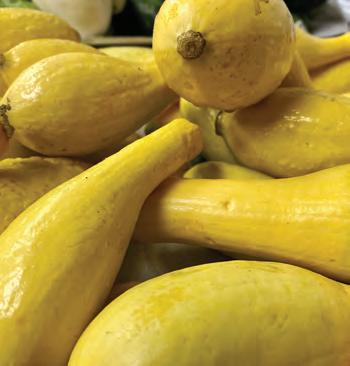

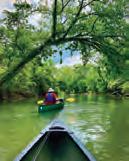


From left, Conservation Commissioner Chris Blankenship, Chef Kyle Ogden, sous chef Taylor Bradley and Chef Jim Smith hoist the winner’s check at the Alabama Seafood Cook-Off at The Wharf.
A dish prepared with one of the tasty fish species that can be reeled in from Alabama’s beautiful beaches was crowned champion of the 9th annual Alabama Seafood Cook-Off at The Wharf in Orange Beach in May.
Chef Kyle Ogden of Odette Restaurant in Florence, Alabama, prepared his “Spring Tide” dish with pompano as the centerpiece, and it proved to be the winning preparation against three other finalists – Chef Emilio Urban from CoastAL in Orange Beach, Chef Justin Fridley of The Depot in Auburn, and Chef Laurence Agnew of Villaggio Grille in Orange Beach.
Story by David Rainer, Alabama Department of Conservation and Natural Resources, Photos by Billy Pope

Odette Chef Ogden carefully plates the winning stuffed pompano dish at the Cook-Off.
Ogden and sous chef Taylor Bradley prepared pompano stuffed with shrimp and crab meat, flavored with the sweet and sour agrodolce sauce, plus fresh Alabama vegetables and herbs for pesto.
“We use pompano quite a bit in the restaurant,” Ogden says. “I wanted our dish to be something you could get in the restaurant while still elevating it to competition level. It really kind of showcased some of the Alabama seafood we use on a regular basis as well as the local produce we use on a day-to-day basis. Kodachrome Gardens is a 501(c)(3) charity garden in Florence. They donate a lot of produce to the community as well as sell to the restaurants. When they sell to us, the proceeds go to the community aspect of their garden. We also used some micro greens that one of our cook’s grandmother grows, called MeeMaw’s Greens.
“This was a really great competition. I was kind of surprised we won. Everybody’s dishes looked great. I had a friend taking pictures so I could see their finished plates. I’m just really happy we were able to win. Thankfully our plate came out exactly how we do it in the restaurant, so I was very, very happy with it.”
The judges – Chef Jim Smith of The Hummingbird Way restaurant in Mobile, Chef Brody Olive of Perdido Beach Resort in Orange Beach, Chef Arwen Rice of Red and White Restaurant in Mobile, and AL.com food writer Bob Carlton – were presented a variety of seafood preparations to judge. The dishes were awarded points in five categories: presentation, general impression and serving methods; creativity and practicality; composition and harmony of ingredients; correct preparation and craftsmanship; and flavor, taste and texture. Each category was worth up to 20 points for a total of 100 points.
Commissioner Chris Blankenship of the Alabama Department of Conservation and Natural Resources said the Alabama Seafood Cook-Off is a great opportunity to market the seafood industry in Alabama.
“A lot of people don’t know what all we do have on the Alabama Gulf Coast,” Blankenship says. “We had coastal chefs, but we also had one from Auburn and one from Florence. They are cooking great seafood from one end of our state to the other. They’re serving it in Birmingham, Montgomery, Florence, Huntsville, Auburn and Tuscaloosa as well as down here on the coast. Anywhere in Alabama, you’re able to get that good, fresh local product.
“Like always, it’s great to get these chefs down here using Alabama seafood. We had snapper. We had croaker. We had shrimp. We had pompano. All four chefs used different types of fish and seafood. They mixed it with good local produce and herbs from Alabama. It’s great see them take Alabama seafood and put it together with other great Alabama products to make dishes that are just outstanding. I appreciate these chefs who take their creativity and really turn it into something special.”

Chef Urban and sous chef Chelsea Holbrook presented the judges with his “Fruits of the Gulf” dish with jumbo shrimp sauteed in a chili-citrus infused oil with a mackerel fume and roasted bell pepper beurre blanc. To finish the dish off, chicharrónes were made from the mackerel skin.
“We try to use every aspect of the fish,” Urban says. “We want to make sure we get everything out of the fish to show respect. The mackerel skin is very nice if you fry it up real nice and add the proper spices – chili pepper and salt. It adds a nice little crunch.
“I started cooking in kitchens a long time ago. I came to the coast when I was 18, and I just fell in love with the seafood scene down here. We are able to get fresh products down here and really showcase the talent that’s down here on the beach and the progression of our cuisine. The culinary scene has increased 10-fold down here, and I’m extremely happy to live on the Alabama Gulf Coast and produce the seafood dishes we do.”
Chef Fridley and sous chef Benjamin Rosen had to step in at the last minute after Chef Robbie Nicolaisen of The Hound in Auburn had to drop out of the competition. Fridley and Rosen prepared jerk-marinated red snapper with grilled watermelon salad with a molasses vinaigrette and goat cheese. Rosen snatched the snapper out of the oven at the last second and the team plated their dish just before time ran out.
“We used fresh citrus, a little bit of sugar and different hot peppers,” Fridley says. “We marinated the snapper as long as possible, so we knew that fish was going to come down to the wire. We hit it on the grill and threw it in the oven to finish it off. Following that theme, we wanted to add fresh season ingredients as well. Snapper is a great fish. We got the call really late, so we had to use what we had on hand. The Hound is a sister restaurant, so we had to step up and support them as best we could.”
To emulate Chef Olive’s winning dish from last year’s competition, Chef Agnew and sous chef Terrance Johnson went with a couple of far less utilized species to prepare “King Billy Whelkomes You,” a play on one of the ingredients – oyster drills that are part of the whelk family. Agnew chose butterflied croakers for the fish preparation and oysters for a stew. A fennel salad was also prepared as well as a salsa verde. The team also made a focaccia
bread crouton with a crab butter spread.
“Oyster drills are known to destroy oyster beds,” Agnew says. “By using oyster drills, Gulf whelks, we could not only create an interest in eating them but also adding a unique item to Alabama seafood production. At the same time, we can eat something delicious and help out our oyster farmers. The drills are purged, like we do crawfish, and then quickly blanched in a courtbouillon style. Then I cooled them down and sliced them razor thin to add to the oyster stew.
“I worked for a chef in New Orleans 20 years ago, and we made tripletail a fun fish to eat, and it’s delicious. It’s all about what more can we use that’s in the Gulf and not overfish any specific species.”
Speaking of Chef Olive’s winning dish of gafftopsail catfish (gafftop or sailcat), he went on to win the Great American Seafood Cook-Off in New Orleans (see related story in June’s Alabama Living).
“That gafftop was a result of a bad day of fishing,” Olive says. “We cooked our bait buckets too – sand fleas and bait shrimp. We turned those into complementing sauces. It was something to have a lot of fun with and challenge ourselves.”
Olive also had fun in New Orleans with the gafftop, a fish that most anglers throw back.
“It was great to be able to shout ‘Roll Tide’ to (Louisiana) Lt. Gov. Billy Nungesser,” he says. “We were right next door to Team Louisiana with all their LSU Tiger stuff. It was such an exciting event, showcasing my two loves in life – being outdoors and fishing and being able to share that experience with friends and family. My parents were there and my wife and kids, so it was an excellent win.
“I always knew I was going to use some underutilized species in the competition. I really just wanted to showcase my true fishing ability, which is not great. It’s better to be lucky than good when it comes to fishing for me. I grew up freshwater fishing (Smith Lake), and catfish was always something prized in my neck of the woods.”
Chef Ogden also gets a chance to follow Olive’s path by competing in the Great American Seafood Cook-Off later this summer in New Orleans.
A project to restore the Eastern indigo snake to Alabama is one step closer to its goal with the release of 40 indigos in the Conecuh National Forest in mid-May. The reintroduction project aims to establish a viable population of this threatened species within its historic range along Alabama’s Gulf Coast.
Representatives from the Alabama Department of Conservation and Natural Resources (ADCNR), Auburn University, U.S. Forest Service, U.S. Fish and Wildlife Service, Zoo Atlanta and the Orianne Center for Indigo Conservation at the Central Florida Zoo attended the indigo release at the Conecuh National Forest located in Covington and Escambia counties in south Alabama.
Chris Blankenship, ADCNR Commissioner, said the project will restore a missing part of the state’s coastal longleaf pine forest.
“Alabama is one of the most biologically diverse states in the country, and we’re excited to be a part of restoring a previously missing piece of our natural history,” Blankenship says. “I am grateful to our partners who are a part of this important project.”
Jim Godwin with Auburn University’s Alabama Natural Heritage Program said the indigo reintroduction project is an example of the importance of the state wildlife grant (SWG) program for the conservation and management of rare species, not just in Alabama but throughout the country. The SWG program provides federal grant funds to state fish and wildlife agencies for developing and implementing programs that benefit species in greatest conservation need and their habitats. ADCNR’s State Wildlife Action Plan identifies 366 species that are in the category of greatest conservation need.
“With this release we will have completed another step toward reestablishing indigos in Alabama,” Godwin says. “This project also serves as the role model for the indigo reintroduction project in Florida, and for future reintroduction projects. What began as a local Alabama wildlife conservation project has demonstrated that the path to recovery is possible through successful, long-term reintroduction efforts.”
The Eastern indigo project started in 2006, and the program was able to start releasing captive-raised indigos in 2010 with 17 adult snakes released into the Conecuh National Forest. The goal is to release 300 snakes to improve the chances of establishing a viable population. The current reintroduction project is modeled on work started by late Auburn University professor Dr. Dan Speake in the 1970s and 1980s.
“Each snake that we have released in the forest is an ambassador for the partnerships that make this project possible,” Godwin says. “Each of our partners and collaborators has played an important role in helping us achieve success with returning the indigo snake to the wild.”
Traci Wood, Habitat and Species Conservation Coordinator with ADCNR’s Wildlife and Freshwater Fisheries (WFF) Division, reinforced the importance of the partnerships behind Alabama’s Eastern indigo reintroduction project.
“This is a pivotal moment in the project,” Wood says. “This year we released 40 snakes for a total of 284 snakes released on the Conecuh National Forest over the past 14 years. Bringing an animal back to Alabama’s landscape after a more than 50-year absence would not have been possible without our partners. This is an exceptional example of the reintroduction of an imperiled species.”
After being released, researchers monitor the snakes’ movements with tracking devices called PIT (passive integrated transponder) tags. They also monitor the snakes with game cameras stationed at gopher tortoise burrows which are utilized by a number of animals, including indigos.
The next indigo release in the Conecuh National Forest is planned for spring 2025.

The Eastern indigo snake is a protected and threatened species throughout its historic range. As the longest snake in North America, it can reach a length of more than 8 feet. Additionally, its diet consists of small mammals, amphibians, lizards and numerous species of venomous snakes including copperheads and rattlesnakes.


Community solar is a unique approach to harnessing power from the sun, giving electric coop members the opportunity to participate in renewable energy generation without the hassle of maintaining solar panels at home.
By Jennah Denney
Across the U.S., electric cooperative community solar projects are thriving. Community solar is a unique approach to harnessing power from the sun, giving electric co-op members the opportunity to participate in renewable energy generation without the hassle of maintaining solar panels at home.
So how does community solar work? The electric co-op oversees the installation of a large array of solar panels, members of the co-op sign up to participate in the community solar program, then participants receive credit for their share of the energy produced from the solar array.
Community solar participants can be individuals, businesses, non-profits and other types of groups. In most cases, participants subscribe to—or in some cases own—a portion of the energy generated by the solar panels. This empowers rural communities to contribute to renewable energy programs, regardless of their individual circumstances.
The advantages of community solar are numerous. For one, participation in a program can lead to significant savings. Some community solar participants can save up to 20% on their energy bills. It’s also a viable alternative for those who can’t install solar panels on their property, such as renters or those with unsuitable roof space. Community solar programs also provide flexible terms, making them an excellent option for renters.
Community solar programs are a popular renewable energy option for electric co-op members because the solar system is owned by the co-op or contracted through a power purchase agreement (PPA), meaning members don’t have to lift a finger. By participating in community solar, co-op members can subscribe to a portion of the energy from these facilities, then receive a payment or credit on their bills that is proportional to their contribution and the amount of electricity the solar project produces.
While community solar projects provide members with access to renewable energy, potential participants should consider potential drawbacks before enrolling in a program, such as tax credits and limited flexibility.
Unlike installing solar panels on your own property, community solar participants may not benefit from federal tax incentives or local rebates. These financial perks are often available to individual homeowners who invest in their own solar systems. Additionally, community solar projects are located off-site, away from your property. This means you have no influence over the solar panel placement or orientation.
If you’re interested in enrolling in a community solar program, consider the savings from your co-op’s standard residential rate, the clear minimum term for participation and access for lowand moderate-income households. Community solar programs typically prioritize access for these households and ensure those subscriptions include strong consumer protections.
The impact of community solar extends well beyond individual subscribers. It bolsters local job creation and community wealth building, enhances the resilience of the local power grid and contributes to the overall reduction of greenhouse gas emissions by generating clean, renewable energy. By producing local, renewable energy, community solar projects can decrease reliance on imported energy sources, leading to more stable energy prices and bolstering energy security for the entire community.
Community solar is more than just a way to save on energy bills. It’s a way to bring communities together, to empower individuals and businesses and to contribute to a more sustainable and resilient energy future. Contact your local electric co-op to learn more.
Jennah Denney writes on consumer and cooperative affairs for the National Rural Electric Cooperative Association, the national trade association representing more than 900 local electric cooperatives. From growing suburbs to remote farming communities, electric co-ops serve as engines of economic development for 42 million Americans across 56% of the nation’s landscape.
July is National Grilling Month! Can you find all the words associated with grilling in the puzzle below? Use the word bank as a guide.
Cooking outdoors is a fun way to spend time with friends and family! By cooking

us









Alabama Living magazine won several awards in the recent national competition of the Cooperative Communicators Association, including top honors in the publications category. The awards were announced at the organization’s annual institute in Des Moines, Iowa.
The magazine’s Communications Department took first place in the category of Member Publications, annual budget over $800,001. The magazine, which consists of 22 separate editions tailored for each electric cooperative, is published monthly as a service to members of those cooperatives.
“The issues were a terrific blend of news, features, and service pieces that engage the readers and meet the stated objectives,” the judges said in their comments. “This is a publication that understands and serves its readers very well.”
Writer Emmett Burnett won two awards: a first place in the Entertaining Feature category for “Jellyfish: an aquatic dinosaur that lives on in our oceans,” which ran in the July 2023 issue; and second place in the same category for “Let’s play (pickle) ball,” in February 2023. The pickleball cover from February 2023, featuring a photograph by Julie Bennett of Opelika Pickleball Club President Jim Young on the court, and designed by Creative Director Mark Stephenson, won third place in the Cover category.
The CCA is a national organization of 350 cooperative communicators who work for various cooperative businesses, such as agriculture, electric and service, from the United States, England and Canada.

Thanks to all of our readers who took the time to take our 2024 Alabama Living Reader Survey! We heard from more than 1,000 of you who either filled out the survey in the printed magazine in January or February, or did so online.
Your answers to our survey questions will help us as we plan future issues of
Identify and place this Alabama landmark and you could win $25! Winner is chosen at random from all correct entries. Multiple entries from the same person will be disqualified. Send your answer with your name, address and the name of your rural electric cooperative, if applicable. The winner and answer will be announced in the August issue.

Submit by email: whereville@alabamaliving.coop, or by mail: Whereville, P.O. Box 244014, Montgomery, AL 36124.
Contribute a photo you took for an upcoming issue! Send a photo of an interesting or unusual landmark in Alabama, which must be accessible to the public. A reader whose photo is chosen will also win $25.
June’s answer: This pretty little chapel at 419 First Ave. SE in Cullman is the Hubert Richter Chapel, built in memory of one of Cullman’s beloved residents. The chapel is open 24 hours a day for those seeking a place of solace and reflection, and is a popular site for small, intimate weddings. It was built in October 1989 with the generous donations of Richter’s friends, family and business associates. (Photo by Allison Law of Alabama Living) The randomly drawn correct guess winner is Emily Margaret Hinson of Cullman EC.
Alabama Living But we can tell you that some of the top features of the magazine are:
• Events Calendar
• Recipes/Cook of the Month
• Alabama People
• Gardening
• Worth the Drive
• News from your electric cooperative
Survey respondents also told us they liked doing our monthly crossword puzzle, the Snapshots column, playing “Find the Dingbat” and the “Whereville” feature.

Many of you took the time to tell us your ideas for stories you’d like to read, recipes you’d like to see and people you’d like us to spotlight. We’ve read all your submissions and look forward to implementing as many ideas as we can, so stay tuned!
Congratulations to the following readers whose entries were randomly selected to receive a $50 gift card:
Roger Engle, Arab EC; Kathie Cleckler, Central Alabama EC; The Luthers, Joe Wheeler EMC; Dorothy Campbell, Wiregrass EC; and Sarah Snarr, Baldwin EMC.
We’ve enjoyed seeing photos from our readers on their travels with Alabama Living! Please send us a photo of you with a copy of the magazine on your travels to: mytravels@alabamaliving.coop Be sure to include your name, hometown and electric cooperative, and the location of your photo.We’ll draw a winner for the $25 prize each month.

Greg and Shari Kennemer, members of Baldwin EMC from Birmingham, took their copy along while attending a destination wedding in Costa Rica. They stayed at the Andez Papagayo Resort on the Papagayo Peninsula in the Northern Guanacaste Region. It was their second trip to Costa Rica and they wrote us “that both the country and people are wonderful.”
Lisa Goggans of Cecil, a member of Dixie EC, was happy to take her magazine on a trip to Jerusalem.
Last month, our readers "traveled" through the June magazine to find the hidden dingbat directional sign. The pesky dingbat was hidden on Page 33 in the photo of the Grille at Botanic in the grassy area behind the lake. Lots of you wrote about looking in the wrong places and having to use your trusty magnifying glasses to find it. Cristal Owens from Hartselle, a member of Joe Wheeler EMC, wrote us, “With a road sign dingbat, I knew it had to be on the road map in the fishing article. Nope.”


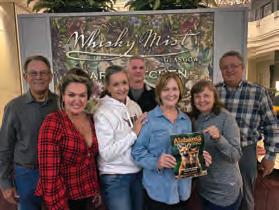
Paula Brickner of Lake Harding sent us this photo that illustrates how small our world really is. A group from Alabama, Georgia, North Carolina and Florida traveled to Scotland and gathered for a photo at their hotel in Glasgow. Paula, a member of Tallapoosa River EC, learned there were other TREC members on the same trip, including LaFayette District Supervisor John Segrest. From left were Johnny Crouch of Seale, Judy Spires of Lake Harding, Paula, John Segrest , Claire Milligan, Rhonda Jackson and and Gil Milligan, all of Lake Harding.


Robert and Carol Houtz of Foley, members of Baldwin EMC, traveled to Marathon, Florida, where they visited the Sea Turtle Center.
Baldwin EMC members Linda and Lewis Gaston of Fairhope went to the Historic Corn Palace in Mitchell, SD, and also visited Mount Rushmore in Keystone.
Congratulations to Melanie Mills of Arab, our randomly selected winner this month. She wins a $25 gift card from Alabama One Credit Union. This month, we’ve hidden a pecan to celebrate National Pecan Pie Day, July 12. Good luck!
By mail: Find the Dingbat Alabama Living PO Box 244014 Montgomery, AL 36124
By email: dingbat@alabamaliving.coop

Solution needed at Grotto


We look forward each month to our copy of Alabama Living magazine. The articles highlighting things to do are always so informative and we learn something new with each edition.
As we read through the current edition today, the article about A-Z things to do in Alabama awakened a new desire to follow through on a promise. Under R was Religious Sites and Ave Maria Grotto was listed.
We not only love going there but it is a favorite place to take visitors who are not from our state. We took a friend from Texas in the middle of May and were very distressed to see a sign on the door stating wheelchairs, motorized scooters, etc. are no longer allowed in the Grotto. We certainly understand why but a thought occurred to us. Someone has the solution. In this day of innovative technology solutions to everything, there has to be a way to allow those with physical impairments the opportunity to see this marvelous work.
We were told the problem is a lack of funds to buy a golf cart (as an example) and no manpower to run the cart if purchased. Perhaps if Alabama Living put out the word, we could find a solution. The ADA does not apply here so it is up to “we the people” to find a solution. Surely in a world where linemen hang from helicopters repairing lines, there is a simple solution!
James and Riki Rager, Boaz
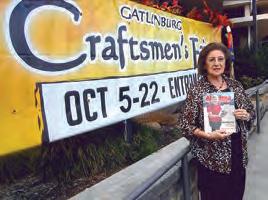
Last fall, Suzy Shepherd and her husband Charles attended the Gatlinburg, Tenn., Craftsmen’s Fair. They are from Georgiana and are members of Pioneer EC.

Story and photos by David Haynes
On a midsummer morning at dawn, the eastern sky brightens with first light, and the sounds of night creatures begin to give way to the first chirping of birds and stirring of squirrels.
An angler silently slips a worn canoe into a perfectly still lake. Moments later, a subtle flick of his wrist casts a fly near a wooded bank. As it floats down to rest on the mirror-like surface, all is silent. Then, in an explosion of water and splashing, the fly rod bends almost double as an aggressive 4-pound bass swims hard to escape.
A few miles away, kayakers are preparing for a day-long float down a creek shaded by a canopy of overhanging trees. They will scarcely need to paddle as the gentle current propels them along. Rounding a bend, they watch as a great blue heron drops from its high perch, spreading its broad wings just in time to fly just above the creek’s surface. As the day warms there’ll be opportunities for cooling off in shaded swimming holes.
On another lake, two friends on stand-up paddle boards (aka SUPs) begin a mile-long paddle to a small island where they’ll spend a relaxing morning watching birds and other wildlife.
For anyone living in Alabama, adventures like these are never more than a few minutes to an hour away. Alabama is ranked seventh in the nation in miles of navigable waterways, and this doesn’t even include many small lakes and creeks that can be accessed by canoe, kayak or SUP.
Paddling excursions can range from a mile or less to multiday trips up to 650 miles on the Alabama Scenic River Trail that begins in the mountains of northeast Alabama and terminates at the Gulf of Mexico, following the Coosa, Alabama and Tensaw rivers.
The 200-mile Bartram Canoe Trail system of canoe and
kayak water trails in the Mobile-Tensaw River Delta is one of the longest in the United States. It offers paddlers 13 different routes, including three routes with floating campsites.
Those wanting to explore paddling adventures have never had so many options as today. The popularity of canoeing and kayaking has been growing for several decades, but has exploded since the Covid 19 pandemic, as outdoor activities in general became more attractive.
Almost every big box store, home improvement store or outdoor store offers kayaks or canoes at prices often starting below $300. For easy or beginner level paddlers, the available watercraft are in three general categories. Each offers advantages and disadvantages:
Most everyone is familiar with canoes. They’ve been around in one form or another for much of recorded history. Canoeists generally use a single blade paddle with a T handle. Modern canoes can be solo (for one person) or tandem (for two people). Canoes designed for lakes and slow-moving water usually have a small keel along the length of the bottom to help the boat track straight. Advantages are comfort level, more total capacity than kayaks or SUPs, and stability. However, canoes are typically larger and heavier and require more effort to haul and put in or take out of the water. Lighter weight canoes are typically made of fiberglass and so can be easily damaged by rocks.
These have been gaining popularity for the past several decades. Kayakers use a double-bladed paddle and so don’t need


to change sides when paddling. Almost all kayaks are now made of durable plastic materials and will stand up to much abuse. For non-whitewater lakes and streams, there are two main types: a decked kayak with a “cockpit” opening, and sit-on-top models that are completely sealed. In general, kayaks are more maneuverable than canoes and easier to put in or take out. They are also easier to haul to and from the streams. Compared to canoes, most people find kayaks less comfortable for longer excursions because the seating position is fixed.
These are relative newcomers to the paddling world but have gained a large following over the past couple of decades. These are basically an oversized surfboard on which the paddler stands and uses a longer single blade canoe-type paddle. They offer the ability to also sit or kneel when paddling and some enthusiasts even bring along their dog, usually perched on the front of the board. Users say they like the versatility of being able to stand, sit, kneel without getting stiff from being in one position. Some even do yoga on SUPs! All are lightweight compared to canoes or kayaks. Different models are available made of polystyrene or are inflatable, making them very portable and easy to transport in
smaller vehicles. However, SUPs don’t offer the stability of canoes or kayaks, particularly in rough water.
And for those unsure if they’d like to buy at personal watercraft before trying it for themselves, dozens of outfitters around the state offer rentals, along with life jackets, waterproof cases/ pouches, etc.
As with any outdoor adventure, paddling excursions do require some advanced planning to maximize the enjoyment of the experience and ensure safety. One important thing to remember is that cellular phone service can be unreliable and sometimes non-existent on trips away from population centers. Phone apps address this by using a smartphone’s GPS to pinpoint its exact locations even when there’s no cellular service. Apps like Relive, AllTrails, and others offer these features and are usually free for a trial period.
If venturing away from civilization, it’s also wise to bring along a basic first aid kit. As with any outdoor activity it’s a good idea to wear a hat, use sunscreen and possibly insect repellant. Also, be sure to let someone know where you’re going and when you expect to return.

Today, adventures often start with web searches in front of a computer, tablet or smartphone screen. The following are a few helpful links: Listing for canoe/kayak rental outfitters: vacationsalabama.com/ kayaking/rentals-outfitters/
(NOTE: This is far from a comprehensive listing. Try searching “Kayak rental near me” as well)
Alabama Department of Conservation and Natural Resources Canoe Trails: alabamacanoetrails.com
List of rivers and streams in Alabama: alabamawhitewater.com/Run/RunList
(NOTE: While this is a website geared toward whitewater adventures, any of the streams listed under “Class I Runs” will be suitable for beginners. A future article will focus on whitewater opportunities in the state.)


By Lenore Vickrey
Aaron Tillman enjoyed his career as a physical therapist, helping people get back on their feet after hip and knee surgery, working with athletes to return to the playing field after an injury. He’d never considered another career, but after working near two doctors of osteopathic medicine, he realized their field of medicine was much like what he was practicing as a therapist. He was intrigued.
“It really opened my eyes,” says the 33-year-old. “It was really in line with what I did with PT.”
While medical doctors (MDs) practice allopathic medicine, which focuses on diagnosing and treating specific diseases, doctors of osteopathic medicine (DOs) treat patients holistically, treating the body as a unit of body, mind and spirit, as well as using manipulation of the musculoskeletal system to aid the body in healing itself.
After connecting with a graduate of the Alabama College of Osteopathic Medicine (ACOM) in Dothan, it wasn’t long before Tillman decided to change careers and moved from Jacksonville, Fla., to enroll in the school himself. Today, he is on track to graduate in 2026, has served as Student Government Association president, and is one of the college’s biggest cheerleaders.
spirit, then being able to address the patient as a person rather than just their diagnosis affects the whole body of care.”
This type of approach to medical education has attracted more than 1,200 students who’ve graduated from the college since it was founded as the academic division of Southeast Health in 2013. It graduated its first class in 2017.
“To begin with, we were accredited to have a class of 150, and it’s now grown to 210,” says Carmen Lewis, PhD, MBA, vice president of institutional effectiveness.

“When we’re doing our clinical rotation, the emphasis with patients is, ‘How is this issue affecting your life?’ ” he explains. “You’re a whole person. If your body is affecting your mind and
“We accept that many each year. That’s the largest medical school by enrollment in Alabama.”
College officials are particularly proud of the fact that their graduates have a top placement rate in residency programs, placing 99 percent in 21 different medical specialties, says Lewis. “We focus particularly on primary care areas — internal medicine, pediatrics, family medicine and obstetrics and g ynecology.”
ACOM was created in 2013 “to address Alabama’s physician shortage and increase access to medical services throughout the tri-state region, particularly primary care.” To date, 77 ACOM graduates are currently practicing in Alabama, with 24 coming back to practice in the Wiregrass area. School officials want to increase those numbers.
“The intent is to get them back to this geographic area to provide healthcare services to the community,” says Rick Sutton, a

healthcare veteran who is president of ACOM and CEO of Southeast Health. Studies show that 75 percent of residents will practice within 75 miles of where they practice residency. “So you want to create more residencies, you want them to stay there.”
James Jones, DO, ACOM’s dean who worked as an emergency physician before joining the college, says the college has worked with eight hospitals in Alabama to create 12 different programs in family medicine, internal medicine, psychiatry and other specialties. “In these hospitals we’ve created 138 new first -year residency slots that weren’t here before 2018,” he says. “This will hopefully do what Rick said, and keep our trainees who are in the state to stay in the state and serve our communities.”
School officials also realize the importance of attracting and retaining quality faculty members.
“If you look across the country, there’s a worker shortage in nearly everything,” says Sutton. “You’ve got to concentrate on retaining people, and we do that.” Sutton points to a recent Gallup survey ranking the college in the 95 percentile nationally for employee engagement. Forbes recently also recognized the Southeast Health Care system, of which ACOM is a part, as the best mid-size employer in the state. “That speaks to the culture we’re trying to build with our staff,” explains Lewis. “People want to be a part of that team.”
ton County clinics, one in Ashford and another in Taylor, are also extending the reach of the college in previously underserved areas.
To carry through osteopathic medicine’s focus on holistic health, ACOM offers a number of wellness-focused features, including a volleyball court, nature trails, meeting-free Wellness Wednesdays, a community garden to grow fruits and vegetables, and an outdoor pavilion/classroom with a teaching kitchen to showcase demonstrations of healthy food preparation.
“We believe we can impact future patients by teaching our students the importance of preparing nutritious meals, which ultimately leads to disease prevention,” says Jones.
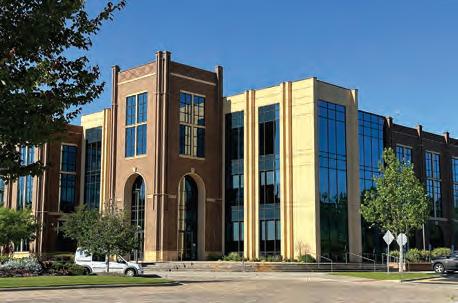
BY LENORE VICKREY
The school also emphasizes the importance of caring with compassion and empathy, Jones adds. “For example, we have a required rotation for hospice,” which is not a typical rotation for doctors in training. “But we believe it’s important to create a kind, compassionate physician.”
Lewis points out that the college operates on three pillars: teaching, research and service. “Especially service to the community,” she adds. “We love this community. It embraces ACOM. It is so heart-warming. “We are committed to giving back, as demonstrated by our students’ extensive community volunteering. During the 2023-2024 academic year, our students completed 10,572 hours of volunteer work.”
ACOM’s 32 different student organizations offer many opportunities for students to give back, Tillman noted. Two rural Hous-
Unique to the school is its Willed Body Program. While many medical schools have come to rely on digital dissection models, ACOM uses cadaver dissection to teach anatomy and its relation to pathology and disease. “Our Willed Body Program is a way for people in this area to make a body donation to help our students,” says Jones. “Having the program is a large benefit to the community, and it costs nothing to the patient or the family.”
Students then pay tribute to the person who helped them in the lab at a “First Patient Memorial Service.” Families are invited to attend, and the names of the donors are displayed. “Our students are very appreciative of that and it’s a great way we serve the community and the community serves us,” says Jones. “The students consider those anatomical donors their first patient.”
As a student who’s experienced the program, Tillman agrees. “It ups the sanctity of the whole anatomical process. I don’t think there’s a better way to learn the human body.” Area residents are also involved in training students through the Standardized Patient Program, Lewis adds, in which local residents are trained to act like real patients in scenarios with students. “They come in, memorize a script, and students examine them and create a treatment plan.”

What’s next for ACOM in the next 10 years? “We want to continue doing what we’re doing and being successful, looking to grow the campus in ways that support our students,” says Jones.
“Our culture is very important to us,” adds Lewis. “People come here, they see the building, that we’re blessed to have a medical center in our system. How many people get to say they’re teaching future physicians? It gets you excited and makes you want to come to work every day!”
Students studying in the ACOM Osteopathic Principles and Principle (OPP) Lab.
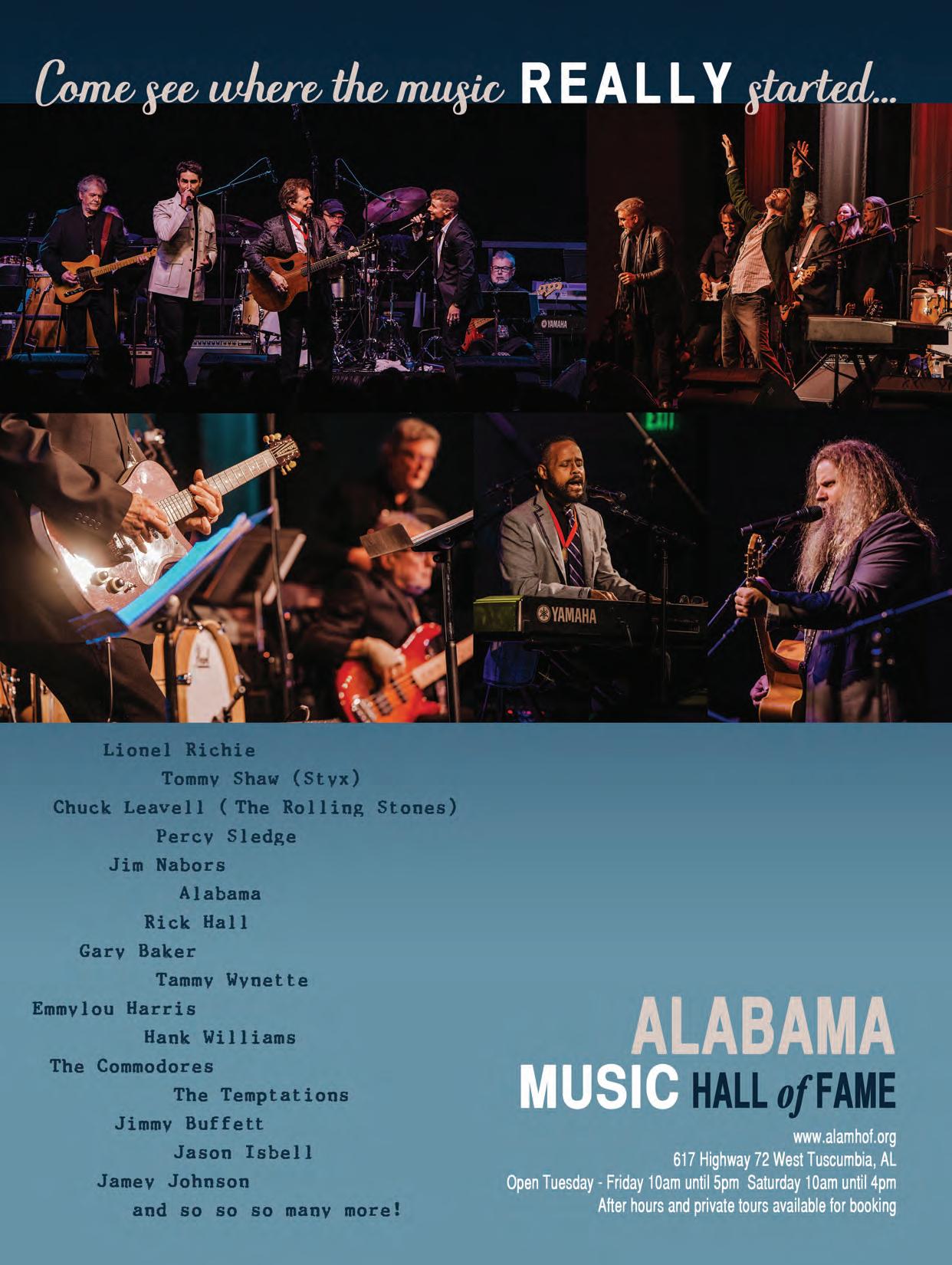

By Emmett Burnett
In the heart of Foley, Alabama’s Heritage Park, stands a train depot, former rail stop, and town fixture since 1909. Well, not exactly. For decades it stood elsewhere and then returned.
Confused yet? Don’t be. For the story behind Foley’s depot turned museum is one of Alabama’s most unlikely tales and starts with the death of U.S. President William McKinley.
Today the town’s former depot is the Foley Railroad Museum and Model Train Exhibit. Memorabilia, exhibits, photographs, and more await visitor discovery. But one of the most intriguing artifacts displayed at the building is the building itself. Here is the story of the little depot that could.
In September 1901, Chicago native John B. Foley was traveling to the funeral of the aforementioned 25th President of the United States. While en route, a railroad land agent told him about amazing south Alabama land for sale. Foley was interested.
Foley helped with his own money in joining Bay Minette to Foley by rail. And then came the train depot. The original was built in 1905 but was destroyed by fire. A new one was built in its place, opening in 1909.
“For decades, this was the center of town,” Hinesley adds, as we tour the building withstanding the test of time. “Settlers first came here by train. Farmers took their crops to market here. Families and businesses grew around this depot.”
All was well until the 1970s when the L&N Railroad discontinued train service to Foley. The depot was destined for demolition until a wealthy area resident came to the rescue.
“a museum quality exhibit, one of the top public exhibits of toy trains in the country.”
John Snook, who owned the Gulf Telephone Company, offered to buy the depot. He and L&N settled on a price with one condition. Snook must move the building. He agreed to the terms and purchased the depot for $1.
A year later he visited the “amazing land,” which would one day share his name. “Mr. Foley came down, looked around, and liked what he saw,” says LaDonna Hinesley, marketing director for the City of Foley. “He bought 40,000-plus acres.”
The Chicago investor formed the Magnolia Springs Land Company to sell parcels of his newly acquired property. But there was a problem. The railroad connected Chicago to Bay Minette but there was no spur joining Foley. He needed train access to sell his lots.
“He bought the building, cut it in half, placed it on trucks, and unloaded it in the woods of Magnolia Springs,” Hinesley says. “Snook used the building for a warehouse initially but it lay vacant for years, buried in the woods.”
Some thought Mr. Snook made a terrible mistake, buying and moving the old depot. He replied to skeptics, “One day the City of Foley will want this building. They just don’t know it yet.” He was correct.
In 1991 Mr. Snook deeded the building to Foley. The town also received grant money to return the Depot from Magnolia Springs to the very spot it stood all those years.
In 1995 the train station’s journey was complete. It was repaired, refreshed, and reopened for visitors. The museum grew from a good idea to a tourist site of 20,000 plus visitors annually.
“I bet when we send our numbers to the state tourism people in Montgomery, they must think we are lying,” says Hinesley, laughing. The Model Train Exhibit also has 20,000 visitors a year, even though it is open three days less than the depot museum is.
Do not compare Foley’s model train sets with the one you got for Christmas. Theirs encompasses a 20-by-60 foot layout with endless tracks, 32 locomotives, and 6 or more trains.
In 2004 the city accepted the original trains from Montgomery donor Alan Goldman. The model trains, hugely popular with children ages 5 to 85, are maintained and operated by about 20 volunteers collectively known as the Caboose Club.
Lifelong Foley resident Bob Irwin is one such volunteer. He remembers the early days of the model train exhibit. “Volunteers took it apart with chainsaws and it sat in storage for a year,” Irwin recalls. The city stored the layout while a building was built to house it. Construction was longer than anticipated due to a contractor shortage caused by Hurricane Ivan. When the building was completed, the trains’ layout was assembled which required a year. Foley’s Model Train Exhibit opened to the public in February 2007. The exhibit has received many accolades, including a September 2019 recognition from Classic Toy Trains Magazine The national publication described Foley’s miniatures as “a museum quality exhibit, one of the top public exhibits of toy trains in the country.”
The set replicates scenes of Foley from the 1940s, including the Foley Hotel, Crosby’s Drugstore, the Holmes Hospital, Foley’s Depot building and other landmarks.
Visitor reaction to the scale models is predictably delightful. “We let children press a button to blow the whistle,” adds volunteer Doc Holiday. “Their eyes light up like the trains.”
One volunteer for the little trains has family history with the big trains. He is John B. Foley III, 80 year-old-grandson of the town’s namesake.
“I am not a train expert, but I enjoy working with these other guys,” he says, looking over the vista of miniature railroads and buildings. To him, the volunteer work in both museum and model train displays are important. The younger Foley sums it up: “I believe if not for the railroad, this city would not be here.”
Fortunately for the rest of us, the depot now museum is here, after burning to the ground, being rebuilt, removed from the city, and returning back to it.
John Foley died and never lived in the city named for him. John Snook died in 1994 and never saw the depot moved to its present location. The train depot owes its existence in part to the elder Foley, Mr. Snook, and others, who were all aboard. The next generation still is.
The Foley Railroad Museum is open Monday through Saturday, 10 a.m. to 3 p.m. The Model Train Exhibit is open Tuesday, Thursday and Saturday, 10 a.m. to 2 p.m.
In addition, children and their parents enjoy The Ebert Express II, a small custom-built train, offering rides around Heritage Park. The Ebert Express II is open Tuesday, Thursday and Saturday, 10 a.m. to 2 p.m. during the summer months. It is open Saturdays, 10 a.m. to 2 p.m. during fall, winter and spring.
All attractions are free but donations are appreciated.
For more information, visit foleyrailroadmuseum.com.

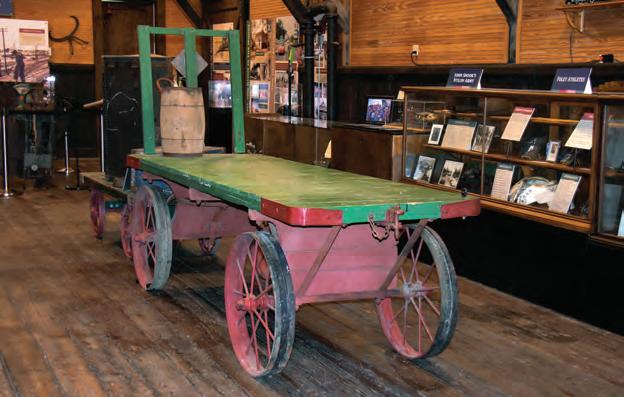

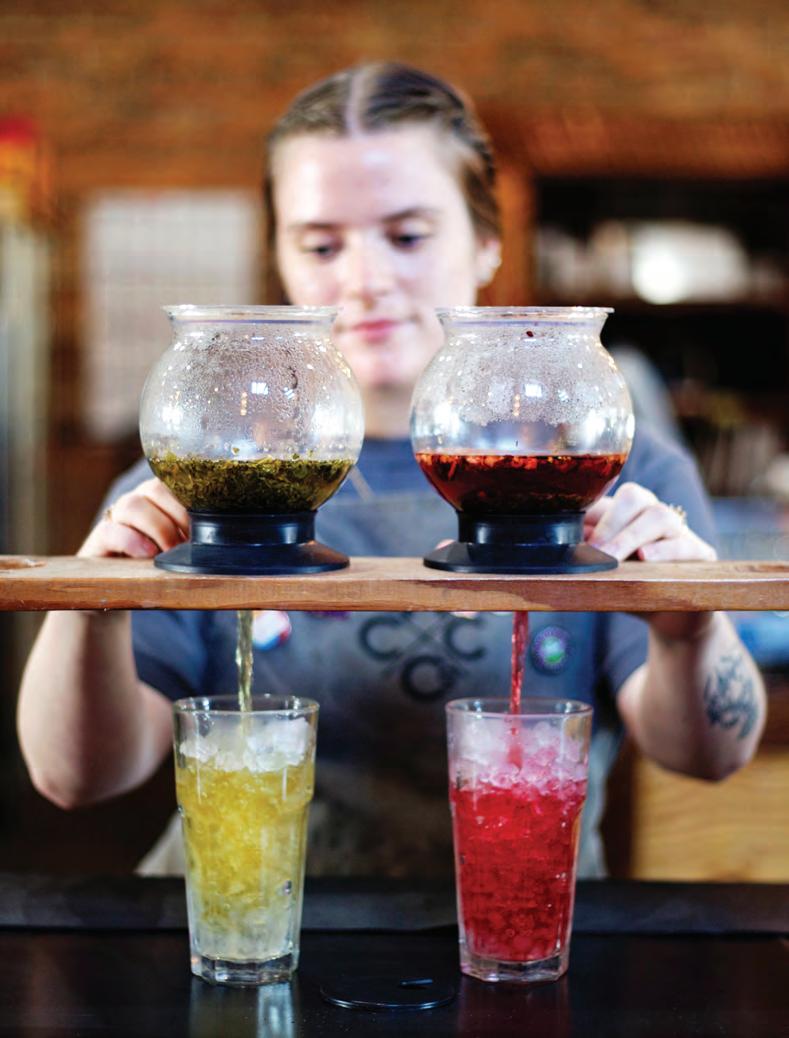


Top: Two varieties of iced tea brewed in a “tea ball” before being served by a Mural City Coffee Co. employee.
Left: Baristas use this contraption called a “Kyoto drip” to brew concentrated tea and coffee drinks. Water from the top container drips over the tea or coffee beans. Though slow, the process results in maximum flavor.
Above: Mural City Coffee Co. also offers a wide variety of loose teas.
By Scotty E. Kirkland
They take coffee seriously at Mural City Coffee Co. Open since 2018, this espresso bar and roastery in historic downtown Dothan is a business and preservation success story.
The company takes its name from the many murals that adorn Dothan’s older structures, a project that began in the 1990s and sparked a downtown revitalization. There isn’t a mural on the side of Mural City Coffee Co.’s building. But, long ago, there used to be. In the early 20th century, a farming-supply and mercantile store owned by William Singletary and A.D. Whiddon originally occupied the space. A stylized mural advertising International brand farming machinery covered the side wall. In the mid-1930s, Archie Carmichael, Singletary’s nephew, purchased Whiddon’s share of the company. Thereafter, it became known as the Carmichael Building. Folks who grew up around Dothan in the 1980s and ’90s likely remember it as the home of Carmichael Electronics.
By the time Gina and Darrin Swan acquired it, the property had been vacant for nearly two decades. The Swans wanted it to become a southern anchor for Dothan’s ongoing downtown revitalization and a gathering place for young and old. The couple met while both were serving abroad in the U.S. Army. While overseas, they would frequent cafés in Germany and other European countries. Back stateside, the Swans dreamed of opening a place of their own where people could sit and sip. Good coffee, like good conversation, shouldn’t be rushed.
But that dream took work. The Swans acquired the Carmichael Building in 2016. Over the next 2 ½ years, they did most of the renovation work themselves, resisting all attempts by contractors to modernize the space, to cover up all its history with new material.
Renovating historic structures is expensive and time-consuming. They sold their house to fund the project.

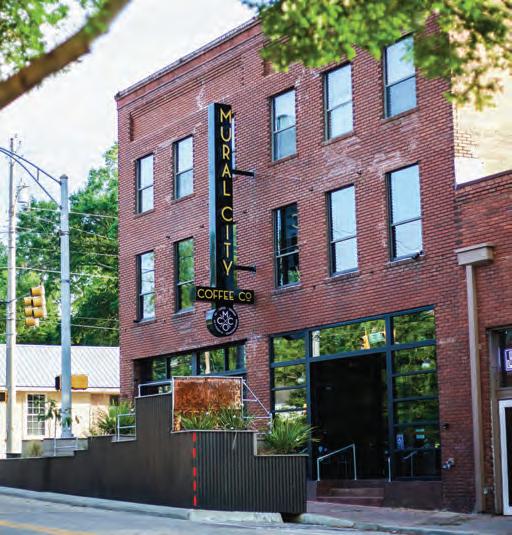
Their son Zach — who now operates Mural City alongside his wife, Destiny — spent six months gently soda-blasting away the dirt and grime from the long-vacant building while preserving its character. The Swans then sanded and repaired the old floors themselves, taking care not to destroy the rough-hewn stories beneath their feet. They preserved the building’s vault, complete with a Singletary and Whiddon-branded safe, and transformed it into a reading nook. Near the counter sits an old rolling cart, an iron workhorse from the building’s earlier history. Today, it holds 50-pound bags of coffee beans from places like Mexico, Brazil and Papua New Guinea.
The imperfections of the bricks and floorboards tell the chapters of the building’s long life — and of the evolution of Dothan. From farming equipment to electronics to espresso. What a story this old structure tells. “We have exceeded our original vision,” Gina Swan says.
On a late-spring morning, the shop is filled with an eclectic mix of patrons. Moms with babes in strollers sip tall, iced coffees. A couple sharing a pot of tea occupies a couch near the welcoming and trendy Malm fireplace. Headphone-bedecked collegians with their noses in laptops and textbooks prepare for finals. Retirees gather around one of the large tables and reminisce. People are reading. People are writing. Somewhere in a corner of Mural City, someone no doubt envisions the “next great American novel.”

Above: William Singletary and A.D. Whiddon opened a dry-goods and farm store along S. Foster Street in 1923. Now, more than a century later, the building is home to the Mural City Coffee Co.
their foam work, an artistic flourish as unique as a fingerprint. Along the walls hang another coffee-house staple: pieces of local art for sale. Mural City also peddles high-end home brewing equipment with names like Chemex and Aero-Press. These aren’t exactly your grandmother’s Black and Decker coffee pot. But do not fret; Mural City offers training. Amid the branded coffee cups, T-shirts and other swag items, a cache of old LPs and cassette tapes are up for grabs, too — the Stones, David Lee Roth, Aretha. What was old is new again, a theme at Mural City in more ways than one. Aesthetics aside, it’s all about the coffee at Mural City. Their beans are roasted on-site to ensure maximum quality. Food & Wine Magazine ranked them among the state’s best a few years ago. Lattes are their most popular drink option, flavored by a series of house-made syrups. Try the lavender or spiced brown sugar options.

PHOTO BY HOLLIE WALDEN
Baristas work the levers and gears of the large espresso machines and roasters as if they were parts of some otherworldly pipe organ. Within an instant, the brew is complete. For dine-in patrons, drinks arrive in hefty ceramic cups. Baristas pride themselves on
Mural City Coffee Co.
192 S. Foster St., Dothan, AL 36301 www.muralcityroasters.com
Hours: Closed on Mondays; 7 a.m. to 9 p.m. Tuesday-Friday; 9 a.m. to 9 p.m. Saturday; 10 a.m. to 6 p.m. Sunday

The baristas don’t neglect the traditional brew, either. With their own roasters and a serious commitment to taste, Mural City’s drip coffee itself is worth the drive to Dothan. One popular variety is Aviator’s Blend, named as a nod to nearby Fort Novosel. The blend is a medium roast made from Colombian and Brazilian beans. An order of it arrives in a carafe with a warmed ceramic cup. Black is best, but the staff oblige requests for half and half.
The tea-drinking set won’t be disappointed, either. Mural City has dozens of loose tea options. They are arranged in big glass jars stacked seven shelves high. Nearby, a repurposed card catalog procured from the University of Georgia offers information and samples of them all.
Swan says there are big plans for the rest of the year at Mural City, including adding an in-house baker to expand their food options. Renovations are also underway for something new on the second floor, the completion of another vision of its founders.
There’s a lively din to a good coffee shop: The gurgle and hiss of the espresso machines, the mix of conversations, the back-counter lingo, vibey music punctuated by laughter and strikes from computer keyboards. Mural City is the kind of place where the time is always right for a fresh cup of coffee.

Summer produce season has arrived, that time of year when we can celebrate the abundance of fresh tomatoes, peas, okra, beans, peppers, corn and myriad other homegrown fruits and vegetables. But this year there’s reason to pay special homage to one of the most popular and prolific garden plants of all, the squash.
That’s because squash has been named the National Garden Bureau’s 2024 plant of the year, a well-deserved honor for a plant that has graced gardens for eons.
The term “squash” is derived from the Narragansett Native American word askutasquash, which means “eaten raw or uncooked,” and refers to a variety of different plants including summer and winter squashes, pumpkins and gourds.
Among the oldest cultivated plants in the world, squashes are members of the Cucurbitaceae family, a category of flowering, vining plants that are native to the Americas. These plants were vital sources of nutrition for the early indigenous people of North, Central and South America who used them in conjunction with beans and maize (corn) to create the “Three Sisters” companion planting system and who also used them for everything from storage to ceremonial vessels.

All these eons later, squash is still a perennial favorite of gardeners worldwide in part because
they are a relatively easy crop to grow. Their large seeds can be planted directly into garden soil where they usually germinate quickly and produce bumper crops of tasty and useful fruits. In fact, botanically speaking all types of squashes are fruits rather than vegetables because they are seed-bearing structures formed from flowers. (Tomatoes, peppers, eggplants, avocados, cucumbers and several other “veggies” are also fruits.)
Squashes are also easy to hybridize, which has led to the development of a diverse selection of pumpkin, gourd and squash varieties for use in home gardens and in commercial production.
What’s the difference between gourds, squashes and pumpkins? Aside from their shapes and sizes, the distinctions are mostly about their uses. Gourd plants produce hard-shelled fruits that, while non-edible, make amazing utensils, storage containers, musical instruments, bird houses and decorative art. Pumpkins are edible (though some varieties are tastier than others) but are also beloved for their decorative qualities while squashes are grown primarily for culinary use, though some can also be quite attractive, too.
As easy as squashes are to grow, they do require full sunlight, fertile and welldrained soil, plenty of moisture and protection from pests to thrive. But when they do thrive, they are usually extremely productive, sometimes to a fault. For example, the prolific yields of zucchini, which is actually an import from Italy, has spawned quips about the need to lock cars and homes in July and August to thwart desperate gar-

deners trying to secretly offload their excess squash. It’s also the reason for this bit of cautionary gardening advice: “plant zucchini only if you have a lot of friends.”
But don’t let that frighten you away from planting squash or any of their cucurbit cousins! Summer squashes and gourds can be still planted this month and on into August and this is prime time to plant winter squash and pumpkins.
Learn more about growing and appreciating squash at NGB’s Year of the Squash website: Ngb.org/year-of-the-squash Lots of information on how to select and grow squash, pumpkins and gourds in the Southeast is available online and through local Extension experts. And, as always, don’t forget to ask experienced fellow gardeners for advice. They may also be great sources of ideas on how to use and give away an overabundance of squash. In fact, next month offers the perfect solution: Aug. 8 is National Zucchini Day, also known as Sneak a Zucchini onto Your Neighbor’s Porch Day.
Harvest summer fruits and vegetables regularly.
Water container plants and newly planted shrubs and trees regularly.
Plant southern peas, beans, squash, cucumbers and pumpkins.
Plant a fresh crop of basil.
Collect seed from plants you want to replant next year.
Share your extra garden produce with local food banks.




Volunteer crews from three Alabama cooperatives braved heat and rough terrain this spring to bring electricity to an unserved area near Jalapa, Guatemala. Crews from Central Alabama Electric Cooperative, Coosa Valley Electric Cooperative and Covington Electric Cooperative worked on the project through NRECA International. The linemen, along with volunteer crews from Middle Tennessee Electric of Murfreesboro, built primary and secondary line, installed transformers and did service drops for the homes, where they also did basic internal wiring. In top photo, Josh Till and Hunter Sparks from Covington Electric Cooperative, Inc., made a new friend in the area of Las Penas. At right, a lineman prepares the internal wiring for one of the homes to receive electricity. The project was coordinated by the National Rural Electric Cooperative Association International, which has worked to electrify unserved areas around the world for more than 50 years.
upplement Security Income (SSI) provides monthly payments to adults and children with a disability or blindness. It also provides monthly payments to adults aged 65 and older who have limited income and resources. SSI

benefits help pay for basic needs like rent, food, clothing, and medicine. People applying for and receiving SSI must meet eligibility requirements, including income and resource limits.
Under our current rules, we include food assistance as unearned income when calculating In-Kind Support and Maintenance (ISM). We understand this rule could affect your SSI eligibility or reduce your payment amount, so we made changes. Beginning September 30,
2024, we are no longer counting food that someone gives you as income when we figure SSI payments. This new rule removes a critical barrier for SSI eligibility due to informal food assistance from friends, family, and community networks of support.
For more information on the SSI program, including who is eligible and how to apply, visit ssa.gov/ssi
Please share this with those who may need it.

by Myles Mellor


3
Alexander City 20th anniversary of Celebrate Freedom 2024 on the front lawn of Benjamin Russell High School on Cherokee Road. Belle Isle Worship, Jordan St. Cyr and Austin French will perform at the concert, which begins at 6 p.m. Food trucks will have food and drinks available for purchase. No coolers, smoking or alcohol allowed. Evening ends with fireworks show. Free. Sponsored by ACRE (Alabama Cross Roads Events). 256-749-4878.
3
Rehobeth Red, White and Boom, 5 to 9 p.m. at Rehobeth High School, 373 Malvern Road. Free. Make and take stations and inflatables for kids, local food vendors and retail and craft vendors. Special concert featuring Walker Montgomery. Search for the event’s page on Facebook.
3-4
Grand Bay 50th anniversary of the Grand Bay Watermelon Festival, Grand Bay Odd Fellows Festival Park. Arts and crafts vendors, food vendors selling barbecue, sandwiches, hotdogs, ice cream and more. Large children’s area. Hours are 3 p.m. to 7 p.m. Wednesday (arts and crafts, food, rides and entertainment); free parking. On Thursday, hours are 10 a.m. to 6 p.m.; $5 per vehicle parking. Food, entertainment, open car show, ice cold watermelon and more. Fireworks at 8 p.m. Thursday. GrandBayWatermelonFestival.org
4 Cullman Smith Lake Park Fourth of July Fireworks Festival, 9 a.m. to 9 p.m. Food, arts and crafts vendors, live music and fireworks. 403 County Road 386. Search for the event’s page on Facebook.
4 Decatur Spirit of America 4th of July celebration, 1 p.m. at Point Mallard Park. Live music all day (featuring Frankie Ballard and Easton Corbin), arts and crafts vendors, car show, food trucks, touch-a-truck, inflatable kids’ zone, hot dog eating contest and fireworks at 9 p.m. Free. Search for the event’s page on Facebook.
4
Dothan Old Fashioned Fourth of July, 5 to 8 p.m. at Landmark Park. Watermelon tasting, picnic spots, games and patriotic music. Martin Drugstore will be open for drinks, shakes,
ice cream and more. $6 adults, $5 kids ages 3-12; free for park members and children under 3. VisitDothan.com
4 Headland Fourth of July Ag Parade and Fireworks, beginning at 4 p.m. with fun on the square. Parade begins at 5 p.m., and fireworks at Douglas Park begin at 9 p.m. Food trucks, glitter tattoos, balloon animals, sweets and more. Search for the event’s page on Facebook.
4
Henagar Sand Mountain Potato Festival, 10 a.m. to 10 p.m. at Henagar City Park. Celebrate the area’s agricultural heritage with live music, arts and crafts, entertainment, games and fireworks, which ends the day. 256-657-6282.
4
Prattville Independence Day activities. Parade in the downtown historic district begins at 9 a.m. and this year’s theme is “party in the USA.” The Lions Club will have barbecue, arts and crafts and live music until 2 p.m. at Pratt Park. Cardboard boat races begin at 10:30 a.m. with awards given. Pratt Pool and Splash Pad will be open. Fireworks will launch at 9 p.m. from the clock tower off U.S. 82 at Legends Circle. 334595-0800.
5-6 Fort Payne DeSoto State Park’s annual Independence Day events atop Lookout Mountain. Event begins at 10 a.m. Friday and conclude at 3 p.m. Saturday. Flag making contest, a splish splash pool party and ice cream social. Free. 256-997-5025.
Tuscumbia, “The Miracle Worker at Ivy Green,” performed on the grounds of Ivy Green, the birthplace of Helen Keller. Gates open at 7 p.m. and play begins at 8 p.m.; patrons are welcome to walk the grounds prior to the performance. Admission is $20 for reserved seats and $15 general admission. 256-383-4066.
20 Clanton 14th annual Chilton County Arts Fest, 9 a.m. to 3 p.m. at the Clanton Performing Arts Center. Free indoor event with vendors selling one-of-a-kind handmade items, jewelry, and all styles of decorative arts. ChiltonCountyArtsCouncil.com
13
Cullman Berlin Farmers Market tractor show. Vendors, inflatables and more. Free entry and registration. 8 a.m. to 1 p.m. 50 Mt. Carmel Drive. 256-736-3138.
13
Mentone the second Blueberry Festival will feature live music, food trucks, art vendors, kids’ crafts, farm tours and u-pick blueberries. Event takes place at the Blueberry Falls Farm, 331 Road 944. 9 a.m. to 5 p.m. Search Blueberry Falls Farm on Facebook.
20
Winfield The Goat Hill String Band in concert at the Pastime Theatre, 7 p.m. Tickets are $20 and available online at itickets. com
Cullman 17th annual Shoot for a Cure 3D Archery Tournament, hosted by the Circle of Hope Cullman. All age groups and levels of competition are welcome; fun rounds are available for those who choose not to compete. Free water along the trail. Awards will be given for each division at 5 p.m. Sunday. Door prizes and concessions available. Camp David in Jones Chapel, 3775 County Road 940. 256-590-1866.
25-28
Mobile Gulf Coast Ethnic and Heritage Jazz Festival. Event begins at 6 p.m. Thursday with an Evening of Poetry at Central Presbyterian Church; $10. The jazz gala begins at 7 p.m. Friday at the Via! Community Center; $35. At 6 p.m. Saturday is Jazz in the City at the Saenger Theater featuring Delfayeo Marsalis and Gino Rosaria. At 3 p.m. Sunday is the jazz and gospel extravaganza at Central Presbyterian Church, $15. Gcehjazzfest. wordpress.com
Northeast Alabama The World’s Longest Yard Sale. More than 650 miles of yard sales and unique treasure finds await travelers along the Lookout Mountain Parkway from Gadsden to Chattanooga, Tenn. VisitLookoutMountain.com
16-17
Russellville 43rd annual Franklin County Watermelon Festival. 6 to 10 p.m. Friday and 10 a.m. to 10 p.m. Saturday. Live musical entertainment both nights; on Saturday, a car show, a 5K race, watermelon contests and more. FranklinCountyChamber. org
To place an event, e-mail events@alabamaliving. coop. or visit www.alabamaliving.coop. You can also mail to Events Calendar, P.O. Box 244014, Montgomery, AL 36124; Each submission must include a contact name and phone number. Deadline is two months prior to issue date. We regret that we cannot publish every event due to space limitations.

Alabama Living on FB instagram.com/alabamaliving

By Scott Flood
Unless you’ve just awakened from an especially long nap, you’ve probably been hearing plen ty about artificial intelligence (AI). It’s likely that much of what you’ve heard is either exciting or terrifying. Movies and TV offer up paradises in which technology frees us from daily drudgery––and frightening scenarios in which machines be come our overlords.
Venkat Banunarayanan smiles when asked if popular media’s takes on AI are accurate. “We’re at the stage of discovery with AI,” he says. “There’s a lot more buzz than reality at this point, and we have a long way to go.”
As the vice president for Integrated Grid Busi ness & Technology Strategies for the National Rural Electric Cooperative Association, Venkat spends some of his time exploring possible use cases with AI, augmented/virtual reality (VR) and other promising technologies, while considering how they might improve the way electric co-ops serve their consum er-members. “Can AI do things better? Can it handle some of the tasks we have to do today? Can it make decisions for us? The answer to those and most other questions is the same: maybe.”
Industry experts agree it’s impos sible to guess where AI will be in another decade or two, but it’s currently not as powerful as Hollywood and the media seem to think.
AI is currently being in corporated for specific tasks and activities, including automated solutions like chatbots that are capable of answering common questions. AI also has the potential to be paired with data analysis, such as retailers using data to better predict customer needs.
Despite what you may have heard, AI is not capable of thinking on its own. The functionality greatly



depends on programming, how the tool is trained to handle specific tasks and the level of data being fed into the system. AI revolves around learning and adapting to decision-making.
Because these new technologies interface with internal and external systems, Venkat stresses the importance of strong cybersecurity. “We need to make sure hackers can’t influence systems,” he warns. “When we consider advancements like AI, we need to ensure protection of personal, critical infrastructure, proprietary and confidential data, too.” Maintaining robust cyber-hygiene is very important and necessary to deploy any technology in a reliable and safe manner––AI is no different in this regard.
As electric cooperatives explore the possibilities of AI, they will focus on underlying needs rather than the technology itself. Examining better ways to accomplish tasks and obtain desired results will guide co-ops as they consider AI tools for more efficient processes and approaches.
Despite all the hype, today’s AI is mostly being used to make incremental improvements to existing products and services. That’s how electric co-ops are likely to experience the growth of AI in the foreseeable future. For example, the next generation of smart meters might incorporate AI tools that help homeowners better manage their energy use. AIbased systems may also be used to improve management of the nation’s power grid, spotting potential problems before human operators can. Electric co-ops could use chatbots to help answer members’ questions and requests more quickly. Weather forecasts are likely to become more accurate, pinpointing the areas most likely to experience damage so crews can be stationed there.
Another promising technology currently explored is augmented reality (AR), and some co-ops are already testing it, particularly in educational and training opportunities. For example, apprentice lineworkers can become comfortable manipulating AR and VR versions of equipment before working with the real thing. Instead of watching a video or a webinar, lineworkers are able to interact with what they’re doing. For example, a safety training can simulate a hazardous situation, like the aftermath of an ice storm or hurricane, providing lineworkers the opportunity to prepare for the real thing.
AR blends VR with the world around us. One day soon, a lineworker may look up at a failed transformer atop a power pole. Their safety glasses will instantly recognize the type of transformer, its exact location and when it was installed before displaying a checklist of the equipment the lineworker may need, a guide to diagnosing common problems, and even 24-hour access to technical experts.
Ultimately, the adoption of AI, VR, AR and other promising technologies share one goal for electric co-ops. From solving outages more quickly, to allowing greater control over energy use, to lowering the cost of service, tomorrow’s innovative technologies will continue to help co-ops enhance the services they provide to their local communities.
For more than four decades, business writer Scott Flood has worked with electric cooperatives to build knowledge of energy-related issues among directors, staff and members. Scott writes on a variety of energy-related topics for the National Rural Electric Cooperative Association, the national trade association representing nearly 900 electric co-ops.





Southern Spicy Pimento Cheese is a Buttered Home favorite. We take a southern favorite and heat it up a bit. Add pepper jack cheese and a touch of cayenne, and it will knock your socks off! Spread it on a cracker, make a celery boat, or tap into that childhood favorite and have it between two slices of bread. It will even change your life if you top your next burger with it! Pimento cheese sandwiches were a staple in my home growing up and this recipe is almost exactly how my sweet Momma makes it, minus the spicy! You can leave out the spicy as well by only using sharp and mild cheddar and omitting the cayenne pepper. For more great southern recipes visit us at thebutteredhome.com.

1 dozen fried chicken tenders (cook from frozen or buy from your favorite fast food chicken place)
1 box Hawaiian sweet rolls (12 to 16 rolls per pan)
1 16- ounce bag tri-color coleslaw mix
1 8- ounce bag sugar snap peas, fresh not frozen
½ cup mayonnaise (recommend: Duke's)
½ tablespoon Dijon mustard
2 tablespoons lemon juice
2 tablespoons dill, freshly chopped
2 tablespoons parsley, freshly chopped
½ teaspoon red pepper flakes
Salt and pepper, to taste
Thinly slice sugar snap peas. Mix with the coleslaw, mayonnaise, Dijon mustard, lemon juice, dill, parsley, pepper flakes, and salt and pepper. Let sit 30 minutes in the refrigerator to combine. Cut the Hawaiian sweet rolls in half and lightly toast. Cut the chicken tenders in halves or thirds and distribute among the bottom half of the roll, then top each roll with around 2 tablespoons of slaw mixture before you add the tops.
Cook's Note: We enjoy experimenting with different slaws for summer sliders. Substitute the sugar snap peas with blue cheese and change the dill to chives, or change sugar snap peas to avocado and change the dill to cilantro! Serve with pickles and chips.
Anna Lynn Mullican Joe Wheeler EMC
8 ounces shredded sharp cheddar cheese, room temperature
12 ounces shredded pepper jack cheese, room temperature
1 cup mayonnaise
½ cup diced pimentos, drained
2 tablespoons apple cider vinegar
½ teaspoon cayenne pepper
8 ounces softened cream cheese
2 teaspoons brown sugar
½ teaspoon salt
Pinch of smoked paprika
In a large bowl, mix cheeses, cream cheese and mayo. Mix well to combine. Add in apple cider vinegar, salt, brown sugar and cayenne. Mix well.Fold in pimentos. Chill for at least one hour. Serve. Garnish with smoked paprika for a pop of color!
Recipes can be developed by you or family members. Adapt a recipe from another source by changing as little as the amount of one ingredient. Chosen cooks may win “Cook of the Month” only once per calendar year. Submissions must include a name, phone number, mailing address and co-op name. Alabama Living reserves the right to reprint recipes in our other publications.
4 boneless chicken thighs
1 teaspoon garlic salt
1/2 cup balsamic vinaigrette salad dressing
1/2 cup cucumber, chopped
2/3 cup mini sweet peppers, seeded and chopped
1/4 cup green onions, chopped
1/4 cup sweet pickle relish
1/3 cup plus 2 tablespoons Duke’s mayonnaise
Spring salad mix
Tomato slices
Hawaiian bread
Season chicken thighs with garlic salt. Drizzle nonstick pan with half of vinaigrette and 1 tablespoon water. Place chicken thighs in pan, drizzle rest of vinaigrette over chicken. Cover and cook thoroughly on low to medium. Chill and chop. Combine sweet peppers, cucumber, green onions and relish. Fold in chicken and mayonnaise. Salt and pepper to taste. Top Hawaiian bread with spring salad mix and tomato slices and add chicken salad. Dig in!
Jill Palmby
Joe Wheeler EMC
3 cups medium shrimp, peeled and cooked
1/2 cup celery, finely diced
1/2 cup ripe black olives, sliced
1/2 cup green onions, sliced
2 hardboiled eggs (optional), finely chopped
Dressing:
¾ cup mayonnaise
2 teaspoons white wine vinegar
11/2 teaspoons Old Bay seasoning
1/2 teaspoon Worcestershire sauce
8 large croissants, split
Combine first four ingredients; then stir in eggs (optional). Whisk together dressing ingredients and add to shrimp mixture, toss gently. Cover and chill. Serve on croissants. 8 servings. Serve with chips, pickles and brownies for dessert.
Nancy Sizemore
Baldwin EMC
1 pound of Frosty Morn Hot Bologna stick , or your favorite bologna, ground or chopped fine
1/2 cup sweet pickle relish
4 eggs, hard boiled, chopped
1 cup Miracle Whip (or mayonnaise if you prefer)
1 small sweet onion, chopped fine
Grind or chop the Bologna with a chopper or food processor. Add all other ingredients and mix well. Chill in the refrigerator for at least 1 hour to blend flavors. Spread on fresh sandwich bread with a little extra Miracle Whip. All ingredients can be changed to your favorite brand or meat and give or take a little to your taste.
Lucindy Prater
Joe Wheeler EMC
Cheesy Chicken Ranch Sandwiches
6 boneless sk inless chicken breast halves
1/2 cup Kraft ranch dressing, divided 1/2 pound (8 ounces) Velveeta, sliced 6 French bread rolls, split Lettuce
Brush chicken with 1/4 cup of the dressing. Spray rack of broiler pan with no stick cooking spray. Place chicken on rack of broiler pan. Broil 3 to 4 inches from heat, 5 to 6 minutes on each side or until cooked through. Top chicken with Velveeta slices. Broil an additional 2 minutes or until Velveeta is melted. Spread rolls with remaining dressing; fill with lettuce and chicken. Makes 6 sandwiches.
Other option: Use a grill to prepare chicken as directed. Grill over hot coals 5 to 6 minutes on each side or until cooked through. Top with Velveeta and continue grilling until Velveeta is melted. Continue as directed.
Sharon Pitt
Joe Wheeler EMC
1 large egg
1/2 cup cola, divided
1/2 cup saltines (about 15), crushed
6 tablespoons French salad dressing, divided
2 tablespooons parmesan cheese
1/4 teaspoon salt
11/2 pounds ground beef
Hamburger buns
Toppings: lettuce, sliced tomato, onion, pick les, sliced cheese
In a large bowl, combine egg, Cola, cracker crumbs, salad dressing, parmesan cheese and salt. Crumble beef over mixture and mix thoroughly. Shape into 6 ¾-inch thick patties. Grill burgers, covered, over medium heat for 3 minutes per side. Brush with mixture. Continue grilling for 6-8 minutes, brushing and turning occasionally. Serve on buns.
Stephanie Tilley Marshall-DeKalb EC


Are you concerned your

A:Q:How do I know if my HVAC system is malfunctioning?
Your heating, ventilation and air conditioning system is one of the most important and expensive systems in your home. Detecting issues early can help you plan for repairs or equipment replacement.
Equipment functionality issues can affect your electricity use, which may result in higher energy bills. The age of your equipment can be a major factor in function. The lifespan of a heating and cooling system ranges from 15 to 20 years.
Proper maintenance and lower use can increase the life of the equipment. To find out the age of your system, look for the manufactured date printed on the unit’s nameplate. If you can’t find it, search online using the model number or call the manufacturer.
Being thrifty by nature, I typically subscribe to the notion of “If it ain’t broke, don’t fix it.” That said, I also believe in being prepared for the inevitable. If your system is approaching or past the 20-year mark, start saving for a new system and get replacement estimates.

There are a few warning signs to watch out for if your heating and
cooling system needs to be repaired or replaced:
Air conditioning is not as cool as usual. If the air from your air conditioner is warm or not as cool as it usually feels, the equipment has an issue. It could be a problem with the compressor or a refrigerant leak. Contact a professional to get the issue checked. Many refrigerants, especially the ones used in older systems, are harmful to the environment. Fix leaks before adding more refrigerant. Special certifications are required for handling refrigerants, so hire a professional to ensure the work is done properly.
Low airflow. If you aren’t getting good airflow, it could be an easy fix, such as filter replacement or opening closed dampers. If you’ve made these fixes and airflow is not at normal levels, contact a professional. There could be a bigger problem with a motor, fan or something else.
Bad odors. Heating and cooling systems sometimes smell when you first start them up for the season. Those smells should be minor and dissipate quickly. Any serious smells—such as burning metal, melting plastic or noxious odors—are a sign that your system is in trouble. If you smell those odors, turn your system off immediately and contact a professional.
Strange noises. There is typically noise associated with the fans and motors in heating and cooling systems. Take note of any excessive or new noises. If your system is making any clunking, clanging or whistling noises, turn it off and check the filter. If that doesn’t solve it, reach out to a pro.
Running frequently. Your system needs to run more to keep up on extreme weather days, but there might be an issue if it runs too often. Short cycling is when a system cycles on and off before completing the heating or cooling process. Contact a professional to diagnose this issue.
Several factors come into play when deciding to fix existing equipment or invest in new equipment. Consider the severity of the issue, repair costs, the likelihood of additional repairs, equipment lifespan and your budget.
The efficiency of your existing system is also a consideration. Heating and cooling technology improvements have come a long way in the last 20 years. Lower operation costs can offset the cost of a new system over time.
Consider your options before you are in desperate need. I recommend getting estimates from at least three contractors. Ask the contractor, “If this was your home, what type of system would you install and why?” The best solution for your home might be a different type of equipment.
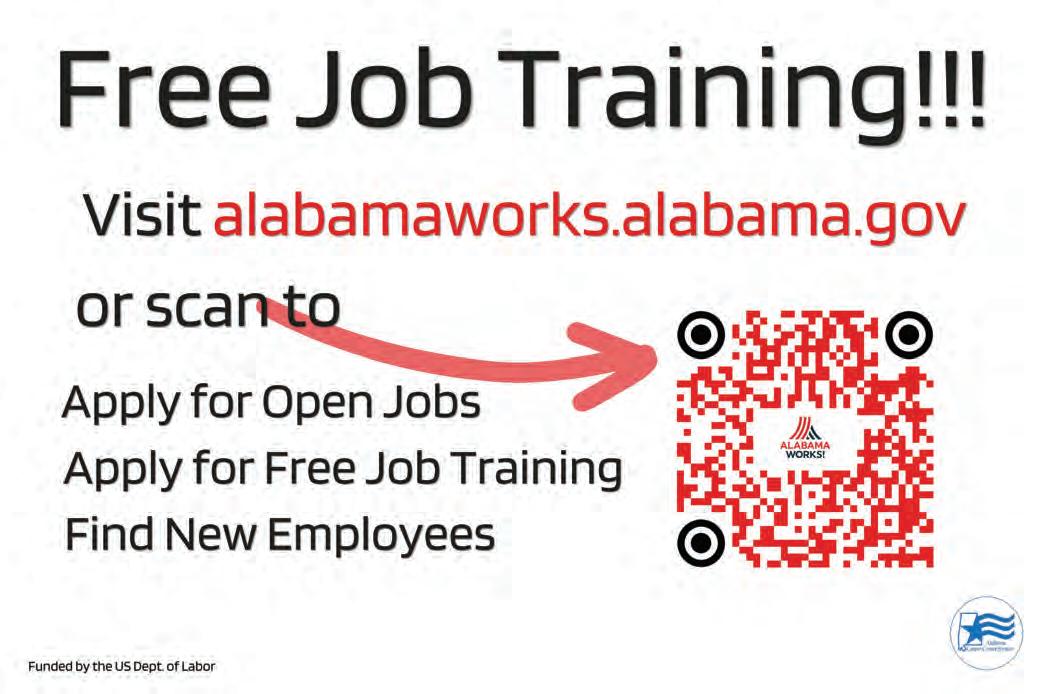


Lightning can hit anyone, anywhere, at any time
Lightning can strike anywhere at any time. According to the Centers for Disease Control, lightning kills about 20 Americans each year and injures many others.
A person walking through a field under a blue sky could suddenly fall to a literal “bolt out of the blue” that originated miles away. Prone to summer thunderstorms in Alabama, lightning occurs here most frequently in July, followed by June and August.
“Lightning injuries are very serious and can result in death,” warns Logan Poole, University of South Alabama graduate and now a National Weather Service meteorologist. “The Gulf Coast is one of the most active areas for lightning activity. Every thunderstorm has lightning with it. Lightning is the trigger for thunder. Even with a non-severe thunderstorm, that lightning hazard is always there. It’s very hard to predict where lightning will strike.”
Essentially a giant spark, technically a “channeled stream of plasma,” lightning forms from static electricity. When walking across carpet in socks, a person could build up a static electricity charge. If that person touches a metal doorknob, it might spark and give the person a mild shock. Imagine what lightning carrying more than a billion volts of energy can do.
“In a thunderstorm, ice particles, water and air rub against each other,” Poole explains. “That builds up a charge of static electricity. When the charge gets strong enough, that massive spark will jump from the thunderstorm to something else not as highly charged. It could be a cloud-to-cloud strike or it could hit an object, like a building, a tree, the ground or a person.”
How far lightning might jump indicates its power. Air does not make a very good conductor of electricity so lightning “struggles” to jump. Eventually, it builds up a charge powerful enough to jump. Therefore, a bolt coming from miles away carries significantly more energy than one close.

Legends hold that lightning cannot strike the same place
but bolts strike some tall buildings multiple times every year. Lightning doesn’t always hit the tallest things, but the tallest objects closer to the sky make it easier for lightning to strike them.
“Golfing is one of the activities that results in the most lightning strikes,” Poole says. “Golfers are holding an object, often made of metal, above their heads in an open area in the outdoors. People fishing in metal boats in open water would be more susceptible to lightning strikes, but more important than the little bit of metal, the height of the person above the water makes a tremendous difference. The odds of getting hit while in a metal boat is not much higher than anyone else, but since metal is a great conductor of electricity they are more at risk if struck.”
If caught in a storm while in a boat, get as low as possible. Take any rods or other tall objects out of the holders and place them on the deck. Lower antennas if possible. Avoid touching metal. The bolt doesn’t need to make a direct hit to affect a person.
When on land, don’t hide under trees. Energy from a bolt striking a tree travels down the trunk into the ground and could affect people or animals around the tree. If possible, get inside a building or a vehicle. If caught in the open lie flat or crouch low to the ground. Put hands tightly over the ears to protect them from extreme noise.
Vehicles can provide good protection. If driving, pull over to a safe place, like under an overpass. When parked, don’t touch the steering wheel or any metal. If lightning strikes the vehicle, it should travel along the metal frame around the person.
The best way to avoid becoming a statistic is to watch the forecast and pay attention to the weather. Watch for rain, black clouds, flashes and listen for thunder. Any summer morning could begin clear and calm, but an afternoon thunderstorm pops up suddenly. Know when to leave. If a thunderstorm begins building, head for shelter or in another direction away from the storm.
“A person needs to be very aware of the weather and take appropriate action,” Poole advises. “If boating, never allow a potential thunderstorm to cut off the route back to port. If something starts to develop between the boat and the shoreline, start seeking a secondary destination close to shore for emergency shelter.”
When lightning threatens, stay home. If outdoors, take precautions to stay as safe as possible.

7315 County Road 17 • Woodville, AL 35776 256-805-0153 • macy@libertymonument.net




• Steel Trusses & Shed Joists
• Pole Barn Kits & Components NOW OFFERING!
• All Steel (Red Iron) Bldg. Kits
2 Week Delivery or Less On: 20’ x 24’; 24’ x 30’; 30’ x 52’


Other Sizes Available - Longer Leads Apply OVER 50 YRS MFG TRUSSES The Moon Clock and resulting Moon Times were developed 40 years ago by Doug Hannon, one of America’s most trusted wildlife experts and a tireless inventor. The Moon Clock is produced by DataSport, Inc. of Atlanta, GA, a company specializing in wildlife activity time prediction. To order the 2023 Moon Clock, go to www.moontimes.com.

We 31 7:42 - 9:42 8:06 - 10:06 2:09 - 3:39 2:33 - 4:03
AUGUST A.M. PM AM PM Th 1 8:30 - 10:30 8:54 - 10:54 2:57 - 4:27 3:21 - 4:51
Fr 2 9:18 - 11:18 9:42 - 11:42 3:45 - 5:15 4:09 - 5:39
Sa 3 10:06 - 12:06 10:30 - 12:30 4:33 - 6:03 4:57 - 6:27
Su 4 NA 12:06 - 2:06 NEW MOON 6:09 - 7:39 6:33 - 8:03
Mo 5 12:30 - 2:30 12:54 - 2:54 6:57 - 8:27 7:21 - 8:51
Tu 6 1:18 - 3:18 1:42 - 3:42 7:45 - 9:15 8:09 - 9:39
We 7 2:06 - 4:06 2:30 - 4:30 8:33 - 10:03 8:57 - 10:27
Th 8 2:54 - 4:54 3:18 - 5:18 9:21 - 10:51 9:45 - 11:15
Fr 9 3:42 - 5:42 4:06 - 6:06 10:09 - 11:39 10:33 - 12:03
Sa 10 4:30 - 6:30 4:54 - 6:54 10:57 - 12:27 11:21 - 12:51
Su 11 5:18 - 7:18 5:42 - 7:42 NA 12:09 - 1:39
Mo 12 6:06 - 8:06 6:30 - 8:30 12:33 - 2:03 12:57 - 2:27
Tu 13 6:54 - 8:54 7:18 - 9:18 1:21 - 2:51 1:45 - 3:15
We 14 7:42 - 9:42 8:06 - 10:06 2:09 - 3:39 2:33 - 4:03
Th 15 8:30 - 10:30 8:54 - 10:54 2:57 - 4:27 3:21 - 4:51
Fr 16 9:18 - 11:18 9:42 - 11:42 3:45 - 5:15 4:09 - 5:39
Sa 1 7 10:06 - 12:06 10:30 - 12:30 4:33 - 6:03 4:57 - 6:27
Su 18 10:54 - 12:54 11:18 - 1:18 5:21 - 6:51 5:45 - 7:15
Mo 19 NA 12:06 - 2:06 FULL MOON 6:09 - 7:39 6:33 - 8:03
Tu 20 12:30 - 2:30 12:54 - 2:54 6:57 - 8:27 7:21 - 8:51
We 21 1:18 - 3:18 1:42 - 3:42 7:45 - 9:15 8:09 - 9:39
Th 22 2:06 - 4:06 2:30 - 4:30 8:33 - 10:03 8:57 - 10:27
Fr 23 2:54 - 4:54 3:18 - 5:18 9:21 - 10:51 9:45 - 11:15
Sa 24 3:42 - 5:42 4:06 - 6:06 10:09 - 11:39 10:33 - 12:03
Su 25 4:30 - 6:30 4:54 - 6:54 10:57 - 12:27 11:21 - 12:51
Mo 26 5:18 - 7:18 5:42 - 7:42 NA 12:09 - 1:39
Tu 2 7 6:06 - 8:06 6:30 - 8:30 12:33 - 2:03 12:57 - 2:27
We 28 7:42 - 9:42 8:06 - 10:06 2:09 - 3:39 2:33 - 4:03
Th 29 8:30 - 10:30 8:54 - 10:54 2:57 - 4:27 3:21 - 4:51
Fr 30 9:18 - 11:18 9:42 - 11:42 3:45 - 5:15 4:09 - 5:39
Sa 31 10:06 - 12:06 10:30 - 12:30 4:33 - 6:03 4:57 - 6:27
